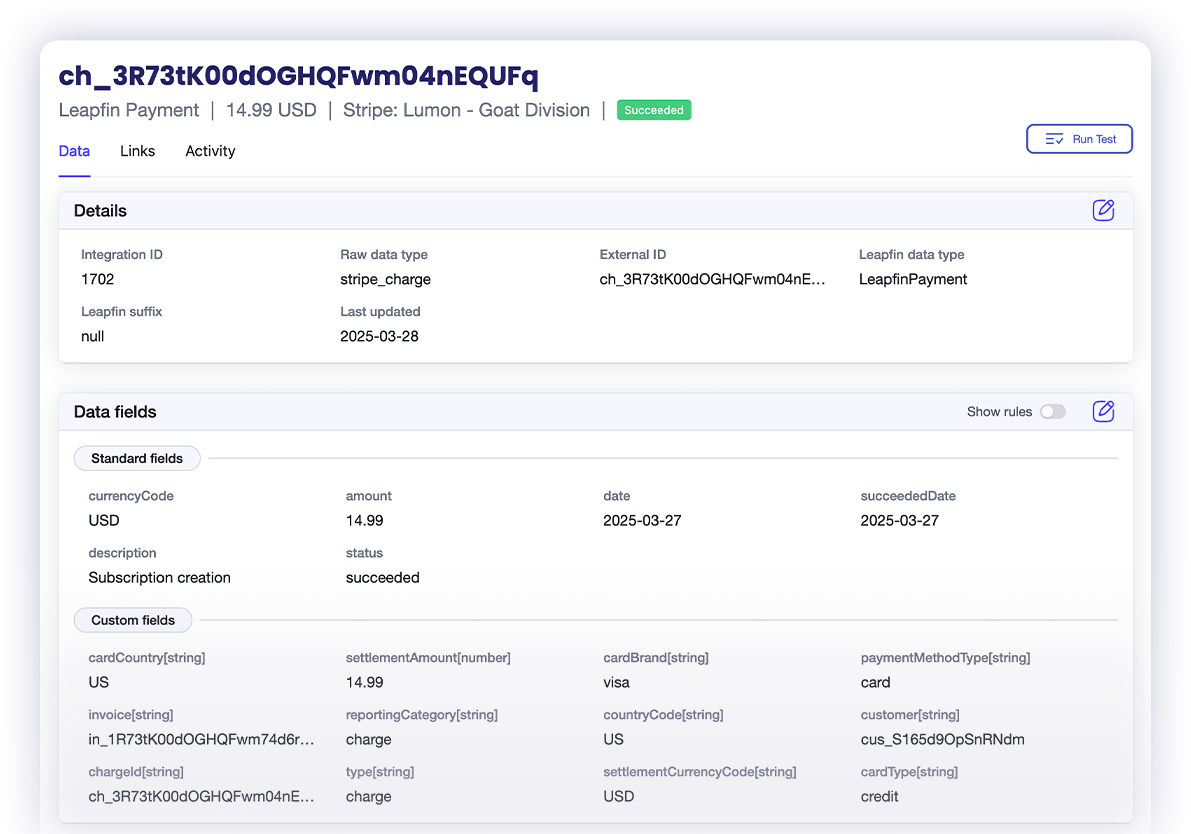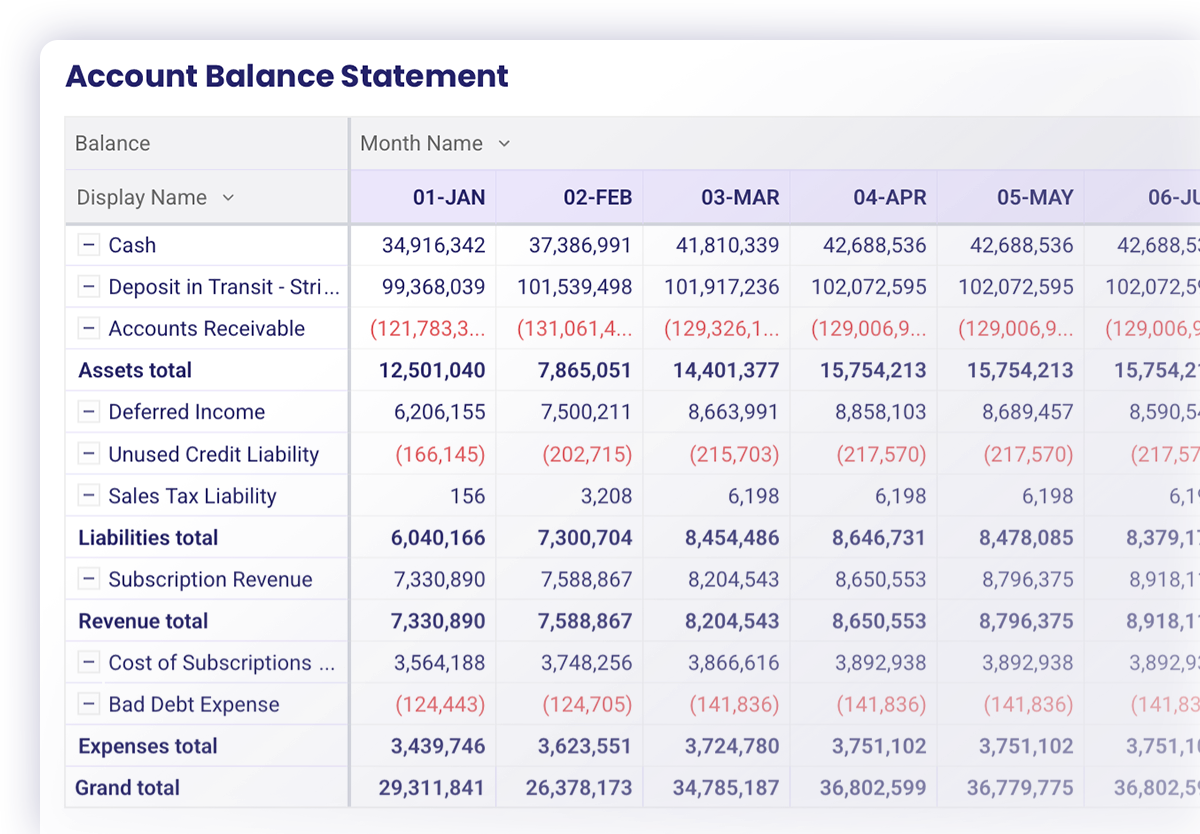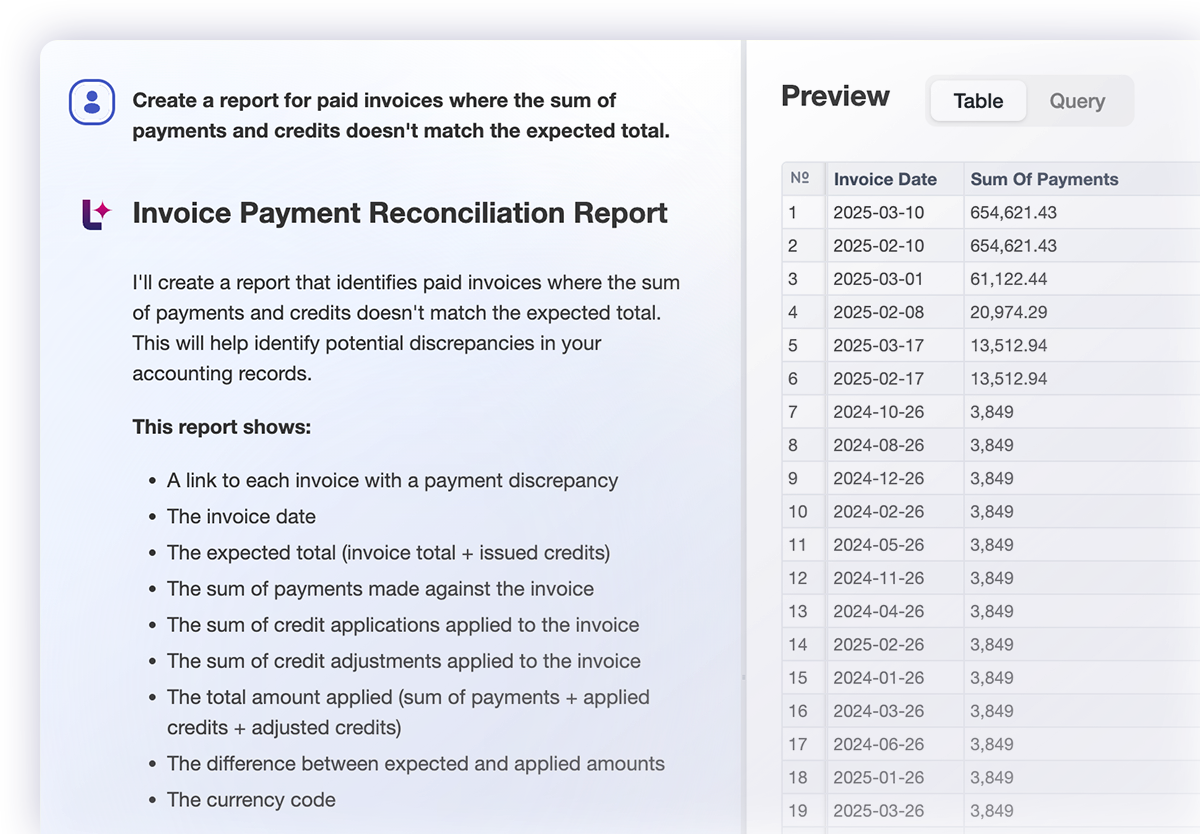Reconcile and prepare Stripe data for NetSuite
Eliminate the burden of exporting and standardizing your revenue data by automating the preparation of Stripe data into journal entries

Transform Stripe transactions into accounting-ready data
Reconciling Stripe data across multiple sheets, formulas, and sources is tedious and exposes your team to potential errors. Because NetSuite is the backbone of your financial reporting, it may seem like connecting Stripe directly would be a better alternative. But the reality is that it can create several new challenges, and drive a significant increase in cost. Data extracted from Stripe is not accounting-ready. It needs treatment to be able to be ingested into your general ledger. That’s where Leapfin can help.
Benefits of integrating Leapfin with Stripe
Enhanced access to transaction data
Leapfin’s native integration with Stripe accesses additional transaction data unavailable in standard reports, allowing for easier, more accurate reconciliation.
Stripe transactions automatically transformed into journal entries
Avoid the time-consuming work of exporting files, cleaning data, and manually creating journal entries from your Stripe data with summarized reports ready for your GL.
Easily explore Stripe data with the help of AI
Easily drill into detailed Stripe transaction data to explore and understand anomalies with the help of natural language prompts using Luca.



Integrate Stripe with Leapfin to gain control of your revenue data
Resources for managing revenue data from Stripe
FAQs
Yes, Leapfin has a powerful native integration with Stripe that has been refined from years of experience. It is available to all customers.
Yes, in many cases, Leapfin would replace Boomi, Celigo, and SuiteSync. When using Leapfin, you would no longer send raw Stripe data with these integration tools. Instead, you will ingest Stripe data into Leapfin. Leapfin will normalize the data, link related transaction events, and prepare journal entries for reconciliation. Leapfin will also prepare journal entry summaries to be shared with NetSuite.
Yes, Leapfin has a native integration with NetSuite that is available to all customers.
Yes, Leapfin has a feature called the Connected Accounting Map that allows users to easily see how all of their Stripe transactions – payment sources, refunds, credits, and disputes – are linked, giving full visibility and traceability into every detail of their revenue data.
Stripe transaction data is raw data that is organized into columns and formats based on the Stripe implementation. It does not consider the characteristics required to be accounting-ready including journal entry formats, currency conversion, timezones, timeframe (relative to month-end close), etc. Stripe data is always changing and has no way of locking data at the end of the month; Leapfin allows users to lock for month-end close and automatically post adjustments in the next period.
Yes, but Stripe users find it to be very limited and difficult to work with. Luca – Leapfin’s AI agent – is purpose-built to support the accounting and finance function, enabling users to easily explore data with natural language prompts. Luca includes dozens of templated prompts to cover many common requests, along with the ability to write original prompts. The results can be easily saved as reports for future reference and shared within your team’s Leapfin workspace.
Much of the data available through the Stripe API is also available in Stripe reports accessible from your Stripe account login. However, there is additional metadata only available through the Stripe API that aids with understanding transaction details and the breakdown required to fully investigate and reconcile revenue data. Leapfin’s native integration with Stripe includes access to this necessary data providing users with a more complete picture of their revenue for reconciliation and reporting.
Real-world examples of improving revenue visibility and accounting efficiency
-
 This isn’t just about automation. It’s about giving our team a system we trust, and the time and space to focus on higher-value work. I’m such a fan. I can’t say enough good things about Leapfin. It has been a huge win for us.Alicia Arntson, CPA VP, Controller, Eight Sleep
This isn’t just about automation. It’s about giving our team a system we trust, and the time and space to focus on higher-value work. I’m such a fan. I can’t say enough good things about Leapfin. It has been a huge win for us.Alicia Arntson, CPA VP, Controller, Eight Sleep -
 I finally feel like I can fully support the numbers I’m posting to NetSuite every month. If someone asks, I don’t need to explain assumptions – I just pull the report in Leapfin.Brian Cheung Sr. Manager, Accounting, GoodRx
I finally feel like I can fully support the numbers I’m posting to NetSuite every month. If someone asks, I don’t need to explain assumptions – I just pull the report in Leapfin.Brian Cheung Sr. Manager, Accounting, GoodRx -
 Leapfin is like our digital glue. It connects all of our financial data sources together so our team isn’t spending time manually tying everything out.Rebecca Wang VP Finance Corporate Controller, Guideline
Leapfin is like our digital glue. It connects all of our financial data sources together so our team isn’t spending time manually tying everything out.Rebecca Wang VP Finance Corporate Controller, Guideline -
 With Leapfin, we are faster, we are more accurate, and we are drama-free. It's transformed our close process. No surprises, no last-minute scrambles. Everything just runs smoothly.Rodrigo Brumana CFO, Poshmark
With Leapfin, we are faster, we are more accurate, and we are drama-free. It's transformed our close process. No surprises, no last-minute scrambles. Everything just runs smoothly.Rodrigo Brumana CFO, Poshmark -
 The feed from Leapfin to NetSuite works seamlessly. It's something that we don't have to worry about anymore.Lindsay Remigio Sr. Manager, Revenue Accounting, Reddit
The feed from Leapfin to NetSuite works seamlessly. It's something that we don't have to worry about anymore.Lindsay Remigio Sr. Manager, Revenue Accounting, Reddit -
 The consolidated view of our revenue in Leapfin is fantastic. In literally one click we can easily see change month to month. And, because every single transaction is right there, we can dig into details for any explanation we may need.Melissa Tuttle Director of Accounting Systems, Outside
The consolidated view of our revenue in Leapfin is fantastic. In literally one click we can easily see change month to month. And, because every single transaction is right there, we can dig into details for any explanation we may need.Melissa Tuttle Director of Accounting Systems, Outside -
 Leapfin helped parse out and make sense of the data that already existed. Simple searches in Leapfin make it easy to track things like refunds, revenue stream trends, and month-to-month movements. Without reporting bottlenecks, Canva is no longer vulnerable to surprises at month-end.Melissa Lee Corporate Controller, Canva
Leapfin helped parse out and make sense of the data that already existed. Simple searches in Leapfin make it easy to track things like refunds, revenue stream trends, and month-to-month movements. Without reporting bottlenecks, Canva is no longer vulnerable to surprises at month-end.Melissa Lee Corporate Controller, Canva -
 With Leapfin, we didn’t need to increase headcount significantly to account for our growth. We were able to double transactions, especially during peak seasons, without growing the accounting team.Ian Booler VP of Finance, Altitude Sports
With Leapfin, we didn’t need to increase headcount significantly to account for our growth. We were able to double transactions, especially during peak seasons, without growing the accounting team.Ian Booler VP of Finance, Altitude Sports -
 Before Leapfin, our reporting processes relied heavily on Excel, and close took up to 90 days. Now, we can close in just 5 days because Leapfin automates our entire data process and revenue reporting so that we can report accurate, validated financials at the end of the month.Minnie Luo CPA, Director of Revenue Operations, Top Hat
Before Leapfin, our reporting processes relied heavily on Excel, and close took up to 90 days. Now, we can close in just 5 days because Leapfin automates our entire data process and revenue reporting so that we can report accurate, validated financials at the end of the month.Minnie Luo CPA, Director of Revenue Operations, Top Hat -
 If you’re a high complexity high transaction volume business, Leapfin is a no brainer.Damien Singh CFO, Canva
If you’re a high complexity high transaction volume business, Leapfin is a no brainer.Damien Singh CFO, Canva -
 Leapfin has completely transformed our month-end close process, eliminating 4 days of manual work, with its ability to handle hundreds of millions of transactions and transform them into a subledger.Joe Blanchett Director, Business Systems, SeatGeek
Leapfin has completely transformed our month-end close process, eliminating 4 days of manual work, with its ability to handle hundreds of millions of transactions and transform them into a subledger.Joe Blanchett Director, Business Systems, SeatGeek -
 The consistency and quality of data we get with Leapfin is excellent. The reduction in our month-end close time has freed up our team to focus on meaningful analysis, driving better business decisions.Jason Grenier CFO, Altitude Sports
The consistency and quality of data we get with Leapfin is excellent. The reduction in our month-end close time has freed up our team to focus on meaningful analysis, driving better business decisions.Jason Grenier CFO, Altitude Sports


